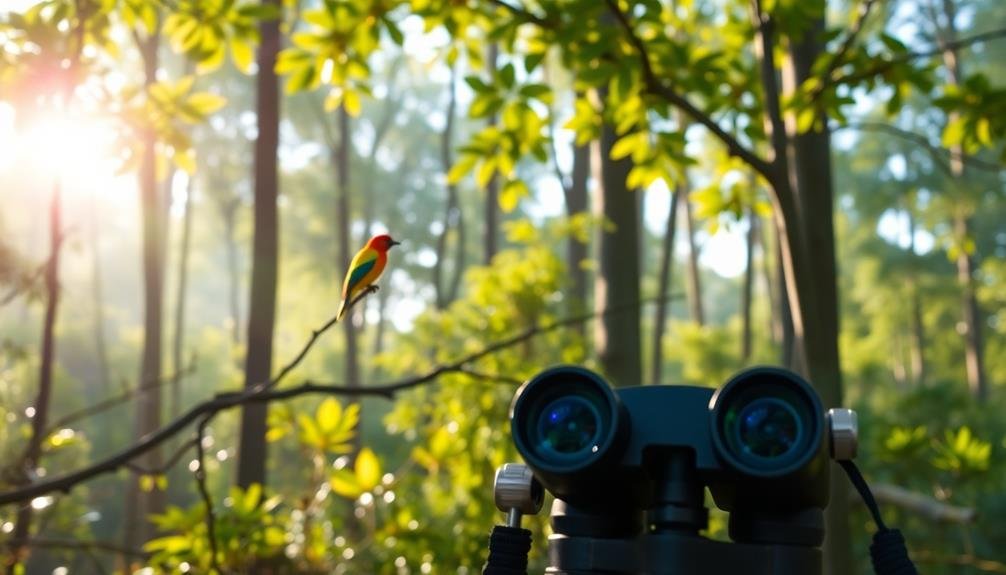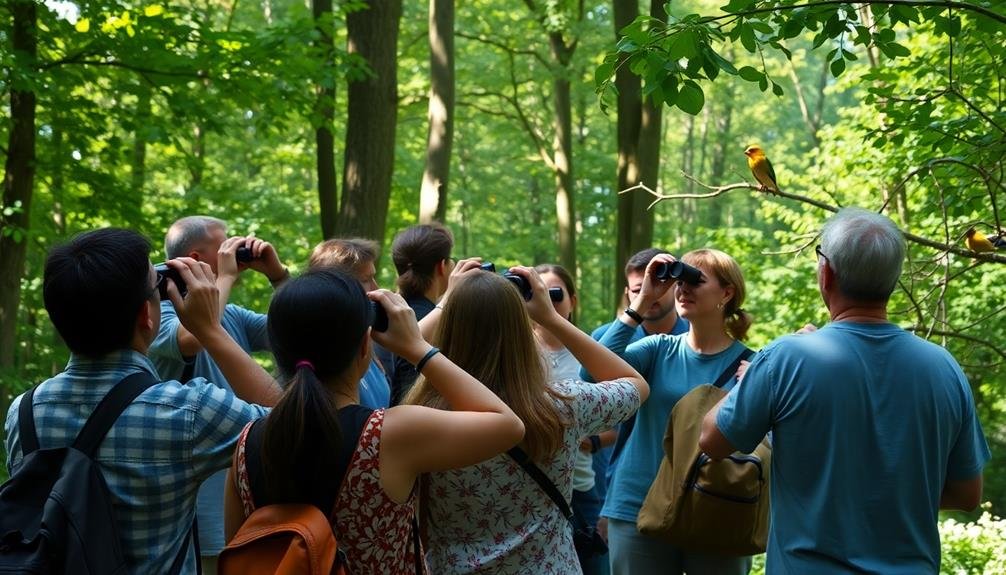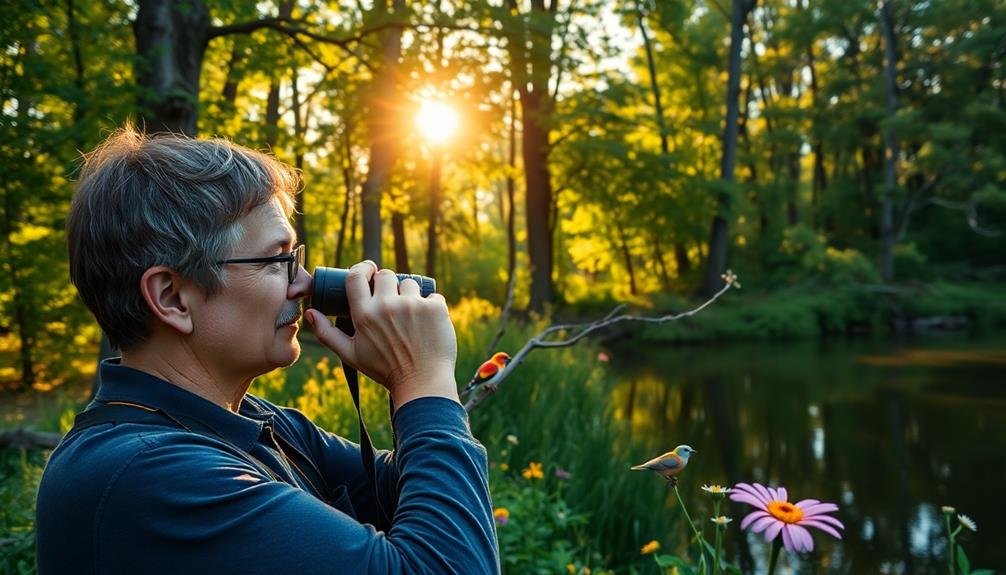Nature immersion eases anxiety by triggering physiological changes that reduce stress hormones and increase mood-boosting chemicals like serotonin. Bird watching, in particular, promotes mindfulness by focusing your attention on the present moment. The sights, sounds, and scents of natural environments activate your parasympathetic nervous system, inducing relaxation. Exposure to negative ions in nature can further enhance your mood and cognitive function. Additionally, the physical activity involved in outdoor pursuits releases endorphins, improving your overall well-being. The accessibility and social aspects of bird watching make it an ideal way to connect with nature and find peace. Explore further to uncover the full spectrum of nature's anxiety-reducing benefits.
The Science Behind Nature's Calming Effect

Research has consistently shown that spending time in nature can markedly reduce anxiety and stress levels. This effect isn't just anecdotal; it's backed by scientific evidence. When you're in nature, your body experiences physiological changes that contribute to a calmer state of mind.
One key factor is the reduction in cortisol levels, the hormone associated with stress. As you immerse yourself in natural surroundings, your cortisol production decreases, leading to a more relaxed state. Additionally, nature exposure increases the production of serotonin, a neurotransmitter that regulates mood and promotes feelings of well-being.
The visual and auditory stimuli in nature also play an essential role. The colors green and blue, prevalent in natural settings, have been shown to have a soothing effect on the brain. Natural sounds, like bird songs or rustling leaves, activate the parasympathetic nervous system, which helps counteract the fight-or-flight response triggered by anxiety.
Moreover, nature immersion often involves physical activity, which releases endorphins and improves overall mood. This combination of physiological responses and sensory experiences explains why spending time in nature can greatly alleviate anxiety symptoms.
Bird Watching as Mindfulness Practice
Bird watching offers a unique avenue for practicing mindfulness and reducing anxiety. When you engage in this activity, you're naturally drawn into the present moment, focusing your attention on the sights and sounds around you. This heightened awareness helps quiet the mind's chatter and worries about the future or past.
As you observe birds, you'll find yourself paying close attention to details like their colors, movements, and behaviors. This level of concentration acts as a form of meditation, allowing you to momentarily set aside your daily concerns. The act of identifying different species also engages your mind in a positive, goal-oriented task that can boost your sense of accomplishment and self-esteem.
Bird watching often requires patience and stillness, which can help slow your breathing and heart rate, promoting a sense of calm. The unpredictable nature of spotting birds adds an element of excitement and novelty to the experience, stimulating the release of dopamine, a neurotransmitter associated with pleasure and reward.
This combination of relaxation and gentle stimulation can effectively counteract feelings of anxiety and stress.
Biophilia and Human-Nature Connection

While bird watching exemplifies one way to connect with nature, it's part of a broader concept known as biophilia. This theory, proposed by biologist E.O. Wilson, suggests humans have an innate tendency to seek connections with nature and other forms of life. It's not just about aesthetic appreciation; biophilia runs deeper, influencing our psychological and physiological well-being.
You'll find that engaging with nature can reduce stress, improve mood, and enhance cognitive function. This connection isn't limited to grand wilderness experiences; even small interactions like tending to houseplants or watching fish in an aquarium can trigger positive responses.
The human-nature bond is so powerful that it's being incorporated into urban design, healthcare, and workplace environments.
When you immerse yourself in nature, you're tapping into an ancestral relationship that's been cultivated over millennia. This connection can help ground you, providing a sense of belonging and purpose that's often lacking in modern, tech-driven lifestyles.
Sensory Engagement in Natural Settings
Stepping into a natural setting, you're immediately enveloped by a rich tapestry of sensory experiences. Your eyes take in the vibrant colors of foliage and wildlife, while your ears tune into the symphony of birdsong and rustling leaves. The scent of pine or wildflowers fills your nostrils, and your skin feels the gentle caress of a breeze or the warmth of sunlight.
This multisensory engagement is a key factor in nature's anxiety-reducing effects. It grounds you in the present moment, directing your attention away from worries and toward the beauty surrounding you. Each sense plays a unique role in this immersive experience:
| Sense | Natural Stimuli |
|---|---|
| Sight | Lush greenery, colorful flowers, bird flight |
| Sound | Birdsong, flowing water, wind in trees |
| Smell | Earthy scents, floral fragrances |
| Touch | Bark texture, grass underfoot, cool streams |
| Taste | Wild berries, fresh air |
Negative Ions and Mood Enhancement

Breathing in fresh air during a nature walk, you mightn't realize you're also inhaling mood-boosting negative ions. These microscopic particles, abundant in natural settings, can have a profound effect on your mental state and anxiety levels.
Negative ions are oxygen atoms with an extra electron, often created by natural phenomena like waterfalls, ocean waves, and thunderstorms. When you're in these environments, you're exposed to higher concentrations of these beneficial particles.
They're believed to increase the production of serotonin, a neurotransmitter that regulates mood and reduces stress. As you spend time in nature, especially near water sources, you're likely to experience improved mood and decreased anxiety.
The negative ions can help alleviate symptoms of seasonal affective disorder and depression. They may also enhance cognitive function, allowing you to think more clearly and feel more alert.
While the exact mechanisms aren't fully understood, research suggests that negative ions can neutralize free radicals, improve oxygen flow to the brain, and regulate sleep patterns.
Birdsong's Impact on Stress Levels
You'll find that birdsong can have a remarkable effect on your stress levels.
The gentle chirping of birds acts as nature's own stress-relief soundtrack, helping to soothe your mind and reduce anxiety.
This auditory aspect of nature's healing power can transport you to a calmer state, even when you're unable to physically immerse yourself in outdoor environments.
Calming Effects of Chirping
In the midst of nature's symphony, birdsong stands out as a powerful stress-reducer. When you listen to the gentle chirping of birds, your body begins to relax and your mind becomes more at ease. This natural sound therapy has been shown to lower cortisol levels, the hormone associated with stress, and increase feelings of well-being.
The calming effects of chirping are rooted in our evolutionary history. Your brain interprets birdsong as a sign of safety, indicating that there are no immediate threats in the environment. This subconscious reassurance allows you to let your guard down and experience a sense of tranquility.
Moreover, the rhythmic and melodic qualities of birdsong can help regulate your breathing and heart rate. As you focus on these soothing sounds, you'll find yourself naturally taking deeper breaths and slowing down your racing thoughts. This mindful listening experience can serve as a form of meditation, promoting relaxation and mental clarity.
You don't need to be an expert ornithologist to benefit from birdsong. Simply spending time in nature and allowing yourself to be immersed in the chorus of chirping can considerably reduce your anxiety levels and improve your overall mood.
Auditory Nature's Healing Power
The healing power of nature's auditory landscape extends far beyond the soothing effects of birdsong. As you immerse yourself in natural environments, you'll encounter a symphony of sounds that can markedly reduce stress and anxiety levels. The gentle rustling of leaves, the babbling of streams, and the rhythmic crashing of waves all contribute to a calming auditory experience.
These natural sounds have been shown to activate your parasympathetic nervous system, which is responsible for rest and relaxation. When you listen to nature's soundtrack, your heart rate slows, blood pressure decreases, and cortisol levels drop. This physiological response helps counteract the effects of chronic stress and anxiety.
Moreover, natural soundscapes can improve your cognitive function and mood. They enhance focus, creativity, and overall mental well-being. By blocking out urban noise pollution and replacing it with nature's harmonious tones, you're giving your mind a much-needed respite from the constant stimulation of modern life.
To harness the healing power of auditory nature, try incorporating nature sounds into your daily routine. Use recordings during meditation, work sessions, or as you fall asleep.
Color Psychology in Nature

Vibrant hues and subtle shades in nature play a considerable role in our psychological well-being. When you immerse yourself in natural settings, you're exposed to a rich palette of colors that can profoundly impact your mood and anxiety levels.
Green, the most prevalent color in nature, has a calming effect on your nervous system. It's associated with balance, harmony, and renewal, helping to reduce stress and promote relaxation.
Blue, often seen in sky and water, can lower your blood pressure and heart rate, inducing a sense of tranquility.
Warm colors like yellow and orange, found in sunsets and autumn foliage, can boost your mood and energy levels. They're linked to optimism and happiness, counteracting feelings of depression.
Purple, seen in flowers and berries, is associated with creativity and spiritual awareness, potentially helping you gain new perspectives on your worries.
Even neutral tones like brown and beige, present in tree bark and soil, can ground you and provide a sense of stability.
Physical Benefits of Outdoor Activities
Engaging in outdoor activities offers a multitude of physical benefits that can considerably reduce anxiety. When you're outside, you'll naturally increase your physical activity level, whether you're hiking, gardening, or simply taking a leisurely stroll. This movement boosts your cardiovascular health, strengthens muscles, and improves overall fitness.
Exposure to sunlight during outdoor activities helps your body produce vitamin D, which is essential for bone health and immune function. It also regulates your circadian rhythm, improving sleep patterns and reducing stress.
The fresh air you breathe outdoors is typically cleaner than indoor air, benefiting your respiratory system and increasing oxygen intake.
Outdoor activities often involve repetitive motions, like walking or cycling, which can induce a meditative state. This rhythmic movement helps lower cortisol levels and promotes the release of endorphins, your body's natural mood elevators.
You'll also improve your balance, coordination, and spatial awareness through varied terrain and natural obstacles. These physical improvements can boost your confidence and self-esteem, further alleviating anxiety symptoms and fostering a sense of accomplishment and well-being.
Social Aspects of Bird Watching

How does bird watching foster social connections? When you engage in this hobby, you're not just observing nature; you're joining a vibrant community. Bird watching clubs and organizations provide platforms for enthusiasts to meet, share experiences, and learn from one another. You'll find yourself participating in group outings, workshops, and annual bird counts, all of which create opportunities for meaningful interactions.
| Social Aspects | Benefits |
|---|---|
| Group Outings | Shared experiences, teamwork |
| Online Forums | Knowledge exchange, global connections |
| Mentoring | Skill development, intergenerational bonding |
Bird watching also bridges generational gaps. It's an activity that grandparents can enjoy with grandchildren, fostering family bonds and passing down knowledge. Additionally, the rise of social media and birding apps has created virtual communities where you can share sightings, seek identification help, and connect with birders worldwide. These platforms allow you to contribute to citizen science projects, making your hobby both socially engaging and scientifically valuable. Whether you're an introvert or extrovert, bird watching offers social opportunities that suit your comfort level, from quiet partnerships to lively group expeditions.
Eco-therapy and Mental Health
Nature's healing power is at the heart of eco-therapy, a growing field in mental health treatment. This approach recognizes the profound impact that spending time in natural environments can have on your psychological well-being. When you immerse yourself in nature, you're engaging in a form of eco-therapy that can greatly reduce anxiety and stress levels.
Eco-therapy encompasses various activities, from simply walking in a park to participating in wilderness programs. As you connect with nature, you're activating your senses and shifting your focus away from daily worries. This natural engagement can lower cortisol levels, decrease blood pressure, and improve your overall mood.
You'll find that eco-therapy isn't just about being in nature; it's about actively interacting with it. Whether you're tending to a garden, observing wildlife, or practicing mindfulness outdoors, you're fostering a deeper connection with the natural world. This connection can help you gain perspective on your problems and develop a sense of calm and resilience.
Mental health professionals are increasingly incorporating eco-therapy into treatment plans, recognizing its potential to complement traditional therapies. By embracing nature as a healing tool, you're tapping into an ancient, yet scientifically supported, method of improving your mental health.
Accessibility of Bird Watching

Bird watching stands out as one of the most accessible forms of nature immersion, available to people of all ages and abilities. You don't need expensive equipment or extensive training to get started. A simple pair of binoculars and a field guide are enough to begin your journey into the world of birds.
What makes bird watching so accessible?
- It can be done anywhere: from your backyard to local parks or even urban areas
- It's a low-impact activity suitable for various fitness levels
- There's no age limit: children and seniors can equally enjoy it
- It's adaptable for people with disabilities, with options like wheelchair-accessible bird blinds
You'll find that bird watching offers flexibility regarding time commitment. Whether you have five minutes or five hours, you can engage in this activity.
It's also a year-round pursuit, with each season bringing different species and behaviors to observe. As you develop your skills, you'll discover a supportive community of fellow bird enthusiasts keen to share knowledge and experiences.
This accessibility makes bird watching an excellent choice for those seeking a connection with nature to ease anxiety and improve mental well-being.
Frequently Asked Questions
What Equipment Do I Need to Start Bird Watching?
To start bird watching, you'll need binoculars, a field guide, and a notebook. Don't forget comfortable clothing and sturdy shoes. A camera's optional but useful. Consider joining a local birding group for guidance and shared experiences.
Are There Any Potential Dangers or Risks Associated With Bird Watching?
You'll face minimal risks while bird watching, but be aware of terrain hazards, ticks, and sunburn. Don't disturb nesting birds or trespass on private property. Always carry water and a first-aid kit for safety.
How Can I Identify Different Bird Species as a Beginner?
You'll want to start with a field guide and binoculars. Learn bird silhouettes, colors, and behaviors. Listen to their calls and songs. Practice regularly in your backyard or local park. Join birding groups for expert guidance.
What Are the Best Times of Day for Bird Watching?
You'll find the best bird watching times are early morning and late afternoon. Birds are most active during these periods. Don't forget to check dawn and dusk for nocturnal species. Weather and seasons can also affect bird activity.
Can Bird Watching Be Combined With Other Outdoor Activities or Hobbies?
You can easily combine bird watching with other outdoor activities. It pairs well with hiking, camping, photography, and kayaking. You'll enhance your experience by incorporating birding into your favorite outdoor pursuits. Don't forget your binoculars!
In Summary
You've discovered the powerful impact nature and bird watching can have on your mental well-being. By embracing these activities, you're tapping into ancient connections, engaging your senses, and practicing mindfulness. Whether you're drawn to the science, the social aspects, or the sheer beauty of birds, there's something for everyone. So grab your binoculars and head outside – you'll be amazed at how quickly your anxiety can melt away in nature's embrace.





Leave a Reply